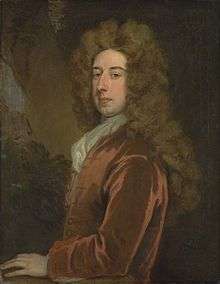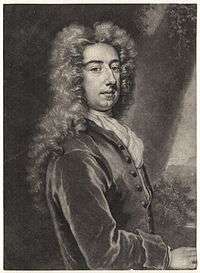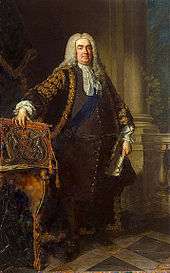Spencer Compton, 1st Earl of Wilmington
| The Right Honourable The Earl of Wilmington KG KB PC | |
|---|---|
 Wilmington, ca. 1710. | |
| Prime Minister of Great Britain | |
|
In office 16 February 1742 – 2 July 1743 | |
| Monarch | George II |
| Preceded by | Sir Robert Walpole |
| Succeeded by | Henry Pelham |
| Lord President of the Council | |
|
In office 31 December 1730 – 13 February 1742 | |
| Monarch | George II |
| Prime Minister | Sir Robert Walpole |
| Preceded by | Lord Trevor |
| Succeeded by | The Earl of Harrington |
| Personal details | |
| Born |
c. 1673 Compton Wynyates, Warwickshire, England |
| Died |
2 July 1743 (aged 70) St James's, Middlesex, England |
| Political party | Whig |
| Alma mater | Trinity College, Oxford |
| Religion | Church of England |
| Signature |
|
Spencer Compton, 1st Earl of Wilmington, KG, KB, PC (c. 1673[1] – 2 July 1743)[2] was a British Whig statesman who served continuously in government from 1715 until his death. He served as the Prime Minister from 1742 until his death in 1743. He is considered to have been Britain's second Prime Minister, after Sir Robert Walpole, although he was largely a figurehead, with real power exercised by the Secretary of State, Lord Carteret.
Early life
Compton, the third son of the 3rd Earl of Northampton, was educated at St Paul's and at Trinity College, Oxford. Thereafter he was admitted into Middle Temple. He entered the House of Commons for the first time in 1698, representing Eye in Suffolk. Although his family were High Tories, he turned to the Whigs after a quarrel with his brother, the 4th Earl of Northampton. In Parliament he soon stood out as prominent amongst the Whigs and began a partnership with Robert Walpole that would last for over forty years.
Political career
In 1707 he became Paymaster of Pensions, a post that he retained for the next six years despite leaving Parliament in 1710 when he disagreed with his patron Lord Cornwallis and the taking of office by a Tory government in that year. It is believed that the Tories retained him as they sought to maintain the support of the Compton family. In 1713 Compton re-entered Parliament for East Grinstead and when the Whigs took power in 1715 he was hopeful that he would enter a high office.
Speaker of the Commons
Instead of the high office he had hoped for, Compton became Treasurer to the Prince of Wales (later George II), and shortly afterwards was unanimously elected as Speaker of the House of Commons. He held this post from 1715 to 1727; one year after his appointment in that capacity, he was invested a Privy Counsellor. He maintained the role despite the split in the Whigs in 1717 in which he joined the Walpole-Townshend alliance and found himself in opposition to the government of the day. He managed to maintain his position through until 1720, when the split ended.
Compton had a reputation for being a lax Speaker, once telling an MP who complained of being interrupted, "No sir, you have a right to speak, but the House have a right to judge whether they will hear you."

When Walpole became the leading minister of the day in 1721 there was speculation about his future should George I pass away and be succeeded by his son, who was more favourably inclined towards Compton than Walpole and declared that he would replace the latter with the former on accession. In order to avoid this, Walpole sought to keep Compton on the margins of government, though he was appointed as Paymaster of the Forces, a very lucrative post, from 1722 until 1730. In 1725, Compton entered Walpole's government as Lord Privy Seal and was also created a Knight of the Bath.
Missed chance
In 1727, George II succeeded to the throne and sought to bring about the change in leadership he had promised. However, Compton was not perceived as a man of great ability. He was described by a contemporary as, "a plodding, heavy fellow, with great application but no talents". In particular he proved unable to compete with Walpole's proposals for an allowance for the King. At a meeting between the three, Compton declared he was not up to the task of government. He maintained a hatred of Walpole for the humiliation. With this passed his last serious chance of holding real control over policy, and his influence sharply declined as a result. He remained on very close terms with George, but the era when Kings could personally select their own ministers in defiance of parliament, was ending.
Patriot Whigs
In order to remove him from the Commons, Walpole raised Compton to the peerage as Baron Wilmington in 1728; two years later, he was created Earl of Wilmington and Viscount Pevensey and appointed Lord President of the Council. He became increasingly associated with the Patriot Whigs, those most critical of Walpole, but in Parliament generally stuck to the official line of the ministry. However, during the Excise Crisis of 1733, he failed to carry through a threat to resign, after being bought off with the promise to make him a Knight of the Garter, which he duly was. This further weakened any following he still commanded. He served as Lord President until 1742.
He was involved in the creation of the Foundling Hospital in 1739, which was an orphanage for abandoned children. This charity became the capital's most fashionable way to prove one's philanthropic credentials and therefore had very notable board members, of whom Wilmington was one.
Prime Minister
In January 1742 he succeeded Walpole as First Lord of the Treasury and head of the Carteret Ministry. Wilmington was a forceful Prime Minister, and grew notorious amongst his cabinet for taking measures without reaching consensus. His strong work ethic took its toll, and his health gradually deteriorated. Even in poor health, he controlled his ministers strictly, making sure they put through the reforms he planned.[3] He remained in office until his death, when he was succeeded by the Paymaster of the Forces, Henry Pelham. He died unmarried and without issue, and therefore all his titles became extinct upon his death.
Wilmington was buried at his family seat of Compton Wynyates in Warwickshire.[4]
Legacy
The cities of Wilmington, Delaware, Wilmington, North Carolina and the towns of Wilmington, Massachusetts and Wilmington, Vermont are named in his honour. In the former, the Compton Towers housing project also bears his name.[5] He never married. His brothers both have descendants in the United States and Great Britain.
Styles from birth to death
- The Hon. Spencer Compton (1673–1698)
- The Hon. Spencer Compton, MP (1698–1710)
- The Hon. Spencer Compton (1710–1713)
- The Hon. Spencer Compton, MP (1713–1716)
- The Rt Hon. Spencer Compton, MP (1716–1725)
- The Rt Hon. Sir Spencer Compton, KB, MP (1725–1728)
- The Rt Hon. The Lord Wilmington, KB, PC (1728–1730)
- The Rt Hon. The Earl of Wilmington, KB, PC (1730–1733)
- The Rt Hon. The Earl of Wilmington, KG, KB, PC (1733–1743)
References
- ↑ Website of 10 Downing Street
- ↑
 "Compton, Spencer (1673?-1743)". Dictionary of National Biography. London: Smith, Elder & Co. 1885–1900.
"Compton, Spencer (1673?-1743)". Dictionary of National Biography. London: Smith, Elder & Co. 1885–1900. - ↑ https://www.gov.uk/government/history/past-prime-ministers/spencer-compton-1st-earl-of-wilmington
- ↑ CompODNB.
- ↑ "Compton Towers". Wilmington Housing Authority. Archived from the original on June 25, 2008. Retrieved 2008-09-26.
- Hanham, A. A. "Compton, Spencer, earl of Wilmington". Oxford Dictionary of National Biography (online ed.). Oxford University Press. doi:10.1093/ref:odnb/6036. (Subscription or UK public library membership required.); cited as CompODNB.
Bibliography
- Browning, Reed. The Duke of Newcastle. Yale University Press, 1975.
- Field, Ophelia. The Kit-Cat Club: Friends who Imagined a Nation. Harper Collins, 2008.
- Pearce, Eward. The Great Man: Sir Robert Walpole. Pimlico, 2008.
- Simms, Brendan. Three Victories and a Defeat: The Rise and Fall of the First British Empire. Penguin Books, 2008.
External links
- Find-A-Grave profile for Spencer Compton, 1st Earl of Wilmington
- More about Spencer Compton, Earl of Wilmington on the Downing Street website.
.svg.png)

.jpg)